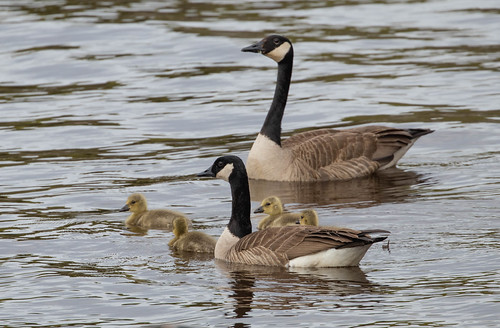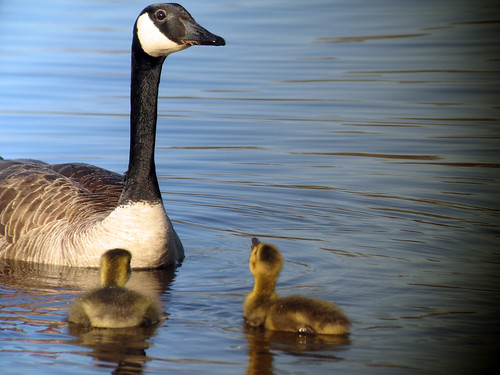On March 17, 1975, when I was a brand new birder, Russ and I went to the Morton Arboretum outside of Chicago, where I saw my very first Canada Geese. There were two—a pair—and I remember one of the people at the desk telling me how thrilled they were because they seemed to be nesting there. Many people have trouble remembering a time when geese nesting in most of the Midwest were few and far between, and seldom if ever in urban parks. We’d see massive movements in spring and fall, of birds flying overhead or coming down in high quality wetlands, but the big numbers really were just passing through. In Madison, Wisconsin, some geese wintered in the Vilas Park Zoo, but come spring, they were never tempted to stick around where life was safe—they had grown up in the northern wilderness, and that’s where they returned, year after year. Geese learn their migration routes from their parents, and by their very nature, they’re conservative traditionalists.
And yet suddenly one pair of geese was violating those family traditions. One thing, and one thing only, trumps tradition for Canada Geese—love. The previous fall, a local nature center had treated an injured goose who recovered but would never again fly. The rehabbers needed a place to release it where water would stay open all winter, and the arboretum seemed just the place. Geese wandering through the area stopped, probably in larger numbers than normal because that one goose was always present, and geese are so gregarious. And over the course of that winter, that injured goose found true love.
Come spring, I’m certain that both geese yearned to migrate north, but if one could not fly, its mate would not fly alone. I’m not sure anyone knew which one, the male or the female, was the one who couldn’t fly, but the other one stuck around and the pair raised young.
Goslings stay with their parents during migration. If the parents can’t fly, the goslings remain where they were hatched. Come spring, those goslings that had attracted a mate there have a decision to make—to fly with the mate or persuade the mate to stay with them. For the arboretum goslings, it wasn’t an issue of being able to fly, and some of them flew north following their own new mates.
All newly paired geese face that dilemma, because young birds that meet on their wintering grounds each flew there with their own parents and siblings. Researchers have learned that usually females are the ones who call the shots as far as where the pair should go when they strike out on their own for the first time. Some males may be more assertive than average, but they generally defer to their mate with regard to where to place the nest—both the exact spot within their territory where she’ll build it and where that breeding territory will be in the first place. She’s the one who invests the most in terms of producing their eggs and incubating them, so it makes sense that the male would trust her judgment.
Geese are happiest with a fairly large territory during nesting, so although the Morton Arboretum did provide enough space for quite a few daughters of that first pair to nest when they reached adulthood, others flew short distances to forest preserves and parks in the Chicago area.
Over the years, for one reason or another, but usually because state DNRs started trying to establish fairly nonmigratory Giant Canada Goose populations for hunters, individual geese here and there ended up nesting in other cities and towns where geese had never nested since urbanization if ever. Generation after generation, new local families radiated out, farther and farther from the original spot. Now Canada Geese nest as well as winter as far south as Florida. And geese being gregarious, as more of them survived in cities and parks where hunting is prohibited, more and more gravitated to those unhunted spots, so hunters didn’t benefit much from the introductions.
Now people seem mystified when I recite that lovely old poem, “Something told the wild geese it was time to fly.” The mysterious and beautiful seasonality of Canada Goose migration may be a thing of the past, but those beautiful geese themselves are here to stay.



